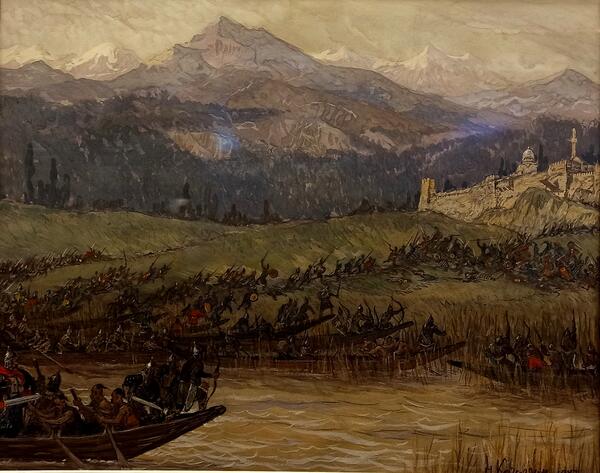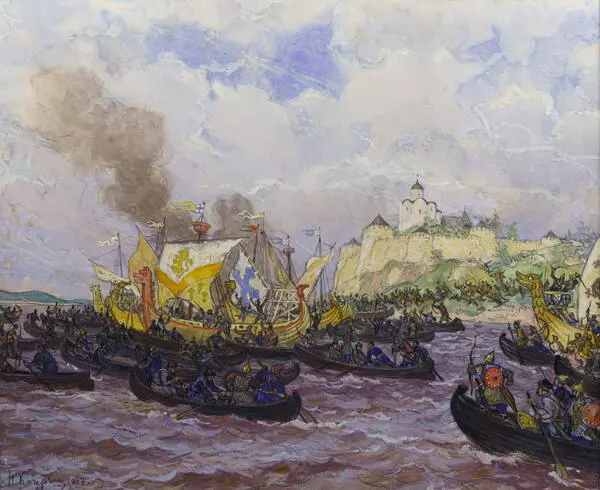The Rus’ began trading actively with the Arabs and Persians as early as the 7th and 8th centuries. These relations were maintained between the 9th and 11th centuries, requiring Russian merchants to sail to the Caspian Sea frequently.
It was in a matter-of-fact tone that the Persian writer Ibn al-Faqih wrote about the voyages of Slavic merchants along the Dnieper, the Black Sea, and the Sea of Azov to the Don and further to the Caspian Sea. Sailing up the Don to the area closest to “the Slavic river” (the Volga), they portaged the vessels and transported them on the Volga which played a significant role in the trading relationship between the Rus’ and the East. The Rus’ also sailed down to the “Khazar” (Caspian) Sea.
The prominent Persian researcher and writer Ibn Khordadbeh, known for “The Book of Roads and Kingdoms” of 846–850, wrote that Slavic merchants “sail to the Jurjān (Caspian) Sea and dock at any coast.” This phrase expressively indicates that the voyages of Russian merchants to the Caspian Sea were quite common in the 9th century. Apart from peaceful trips of merchants, in the late 9th century and throughout the 10th century, the Rus’ carried out several military campaigns to the Caspian Sea. The most famous of these are the campaigns of 913–914 and 943–944 described by the Arab writer Al-Mas’udi in “The Meadows of Gold”.
They also visited Azerbaijan, including Baku. Several eastern writers mentioned the campaign of 943–944. For example, Ibn Miskawayh described the Rus’ in the following way, “They (the Rus’) are a powerful people who are naturally strong and who are very courageous. They do not know defeat, and none of their men turns away from battle until he is killed or kills his opponent.” The strong Rus’ forces were joined by the Alans (Ossetians) and the Lezgins, went from the northeast, reached Derbent in Dagestan, got aboard, sailed down south, passed the Absheron peninsula to the estuary of the Kura River, and sailed up the river to the place known as Barda. Having conquered this settlement and spent a long time there, the warriors boarded their ships and left. There is no information about their subsequent fate. In the 10th century, the Rus’ also sailed across the Caspian Sea and reached the coast of Shirvan.
All of these historic reports demonstrate clearly that the people of Kievan Rus’ had all the necessary skills of mariners and had their own flotillas that sailed across the Black Sea, the Sea of Azov, and the Caspian Sea both in peaceful times for maintaining trade with many foreign lands and during military campaigns.
It was in a matter-of-fact tone that the Persian writer Ibn al-Faqih wrote about the voyages of Slavic merchants along the Dnieper, the Black Sea, and the Sea of Azov to the Don and further to the Caspian Sea. Sailing up the Don to the area closest to “the Slavic river” (the Volga), they portaged the vessels and transported them on the Volga which played a significant role in the trading relationship between the Rus’ and the East. The Rus’ also sailed down to the “Khazar” (Caspian) Sea.
The prominent Persian researcher and writer Ibn Khordadbeh, known for “The Book of Roads and Kingdoms” of 846–850, wrote that Slavic merchants “sail to the Jurjān (Caspian) Sea and dock at any coast.” This phrase expressively indicates that the voyages of Russian merchants to the Caspian Sea were quite common in the 9th century. Apart from peaceful trips of merchants, in the late 9th century and throughout the 10th century, the Rus’ carried out several military campaigns to the Caspian Sea. The most famous of these are the campaigns of 913–914 and 943–944 described by the Arab writer Al-Mas’udi in “The Meadows of Gold”.
They also visited Azerbaijan, including Baku. Several eastern writers mentioned the campaign of 943–944. For example, Ibn Miskawayh described the Rus’ in the following way, “They (the Rus’) are a powerful people who are naturally strong and who are very courageous. They do not know defeat, and none of their men turns away from battle until he is killed or kills his opponent.” The strong Rus’ forces were joined by the Alans (Ossetians) and the Lezgins, went from the northeast, reached Derbent in Dagestan, got aboard, sailed down south, passed the Absheron peninsula to the estuary of the Kura River, and sailed up the river to the place known as Barda. Having conquered this settlement and spent a long time there, the warriors boarded their ships and left. There is no information about their subsequent fate. In the 10th century, the Rus’ also sailed across the Caspian Sea and reached the coast of Shirvan.
All of these historic reports demonstrate clearly that the people of Kievan Rus’ had all the necessary skills of mariners and had their own flotillas that sailed across the Black Sea, the Sea of Azov, and the Caspian Sea both in peaceful times for maintaining trade with many foreign lands and during military campaigns.







